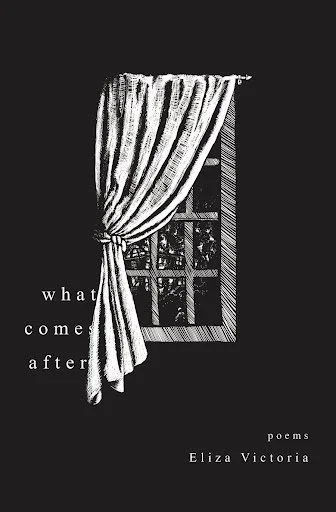Eliza Victoria’s ‘What Comes After’ Finds Urgency After the Mendiola Protests Media Blackout
Eliza Victoria’s ‘What Comes After’ Finds Urgency After the Mendiola Protests Media Blackout
What Comes After cover page. | Taken from Goodreads.
What happens after the crash, the capture, the gunshot, the explosion, the crime, the massacre?
On the back cover of What Comes After, the first book-length collection of poetry from Palanca-winning author Eliza Victoria, poet Conchitina Cruz presents a litany of questions. What initially registers as provocation becomes, upon reading, not only a rhetorical hook, but a faithful distillation of the collection’s force. Behind its vitality are poems that examine the aftermath of violence, casting the preceding sadness as both testimony and indictment. It constitutes a form of redemption in itself as opposed to the familiar impression of passive surrender.
Some poems situate themselves within the Filipino experience of unattended mourning while others confront universal frustrations refracted through the personal. Rich detail and somber accuracies courses through each context from which Eliza directs her poetry. It makes turning the pages feel like processing loss along with someone at the current space of their grieving. Each piece strains toward the far side of the gulf, measuring how distant its edge remains. What do these unexpected deaths and unwarranted violence really entail across such empty spaces?
The echoes of this work, far from fading, strike with greater urgency in today’s Philippine sociopolitical climate, where mainstream media so often fashions their coverage with selective attention that by turning away from certain truths, the general audience is also pulled by their safe bets that benefit none of what it's supposed to be serving in the first place. The media blackout that shrouded the recent Mendiola protest could scarcely provide a clearer, more telling example of this.
What happened on September 21, 2025 didn’t surprise anyone. It was the culmination of years of quiet but deliberate violence inflicted on Filipinos. Reinforced by the EDSA People Power anniversary, various independent and church organizations coordinated to make a movement in the same vein of what the date meant years ago. Thousands came out for the Trillion Peso March in Quezon City and Baha sa Luneta in Mendiola, rightfully seeking justice, where accountability had never stood in equal weight to the crimes. All in protest against the anomalous flood control projects that drained the people’s pockets, even as we continue to endure annual tax hikes and worsening livelihood conditions. The punchline is that our sacrifices had been diverted into pipelines of power and unchecked accumulation.
As such, our collective anger is more than justified; yet when it erupted in Mendiola, it cannot be narrowly defined as a failure of the reliably convenient buzzword of “peaceful protest.” To do so is to overlook how the very condition of “peace” has long been denied to those relegated to the margins. Assigning descriptors and condemnations may appear orderly, but they deflect from the systemic roots of the unrest. What unfolded in Mendiola was chaotic by nature but an outward manifestation of exhaustion and cumulative betrayals that we can't easily reduce by blaming. Unfortunately, these were subsequently reframed by the media into a narrative where state violence was publicized as necessary intervention.
This kind of erasure by curation, however, is precisely what Victoria’s poetry refuses. Where official accounts sanitize, her words insist on the raw aftermath: the “buildings mocking with silence, fifty-seven count of bodies” and “borrowed spaces we take for granted.” In this sense, What Comes After anticipates not just mourning but also a counter-archive: a way of knowing that we can always preserve what power tries to conceal and accept grief as the necessary means to turn the tables around.
While Victoria’s work does not directly address the Mendiola protests, her reflections from years ago continue to resonate, confronting the Filipino struggle not only against forgetting but also the systemic pressures that make forgetting possible.
Take for instance in Somebody Tell the River. Victoria observes that water “…is not the only thing that can kill without bruising." Among the many brilliant pieces containing such lines, I feel as if this can serve as the linchpin of what she tries to dissect. It reveals with lyrical polish how pain can persist unseen, leaving no discernible mark. Its effects unfold gradually and are easily overlooked, absorbed into the rhythms of everyday endurance rather than arriving in a single, dramatic moment.
In the same way, forgetting operates quietly. It does not begin with abrupt erasure, but with the normalization of incompetence and the slow acceptance of what should never have been forgotten. Yet, as Victoria reminds us, there will always be people willing to remember and hold the aftermath tightly, those who understand that awareness and memory itself can be an act of defiance.
What Comes After’s formal inventiveness adds an edge to this politics of remembrance. One poem assumes the guise of a dictionary definition, an act that at first seems clinical and even cliché, but soon justifies itself through a clever conceit: it uses the rigidity of the form to liberate meaning. Elsewhere, lines are struck through yet remain legible, a visual gesture that dramatizes censorship without resorting to didacticism. Such restraint becomes her rebellious energy, as she plays with space, structure, and pronunciation. Similarly, her use of local imagery — a moth as grandfather, a karinderya as a space of sustenance — grounds her longing in the Filipino ordinary. The familiarity of these details grants her poetry an intimate breadth, where private loss and collective history meet.
Even disregarding the culture-specific particulars, Victoria’s poetry resists simplification. Each page carries a rich, broader commentary on the lingering trails of violence, whether personal, historical, or institutional. Her collection, brief as it may be, more than earns its brevity; it condenses a panoramic fold of remembrance into unassuming acts of witness. In an age where reportage itself can be twisted (though not all), her poetry offers a rarer kind of coverage: clear, potent, and unyielding to the neatness or control that politics demands. Fittingly, she even has a piece titled Reportage, as if to reclaim the very language through which truth is often distorted.
To describe what is happening in the Philippines today, most painfully the absence of honest coverage on what truly transpired during and after the Mendiola protests, is to face a frightening reality. It is now the common people, through the grainy footage they share, who keep the truth alive; their videos exposing the widening gap between public testimony and institutional truth. In Topography, Victoria writes: “...memories erode like buildings, what is left standing is true.” And so, if truth is to survive, we must learn to endure as those before us did, persevering until we earn what has long been owed. In the meantime, we might translate what endures in the aftermath to lay claim to the possibility of what comes next.


















